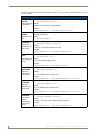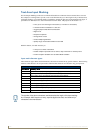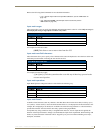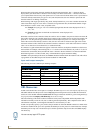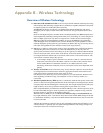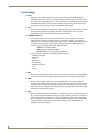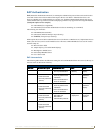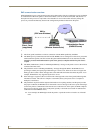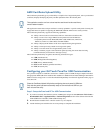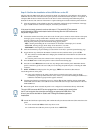
Appendix B - Wireless Technology
198
NXD-700Vi 7" Modero® Wall/Flush Mount Touch Panel with Intercom
Terminology
802.1x
IEEE 802.1x is an IEEE standard that is built on the Internet standard EAP (Extensible
Authentication Protocol). 802.1x is a standard for passing EAP messages over either a wired
or wireless LAN. Additionally, 802.1x is also responsible for communicating the method with
which WAPs and wireless users can share and change encryption keys. This continuous key
change helps resolve any major security vulnerabilities native to WEP.
AES
Short for Advanced Encryption Standard, is a cipher currently approved by the NSA to protect
US Government documents classified as Top Secret. The AES cipher is the first cipher
protecting Top Secret information available to the general public.
CERTIFICATES (CA)
A certificate can have many forms, but at the most basic level, a certificate is an identity
combined with a public key, and then signed by a certification authority. The certificate
authority (CA) is a trusted external third party which "signs" or validates the certificate. When
a certificate has been signed, it gains some cryptographic properties. AMX supports the
following security certificates within three different formats:
- PEM (Privacy Enhanced Mail)
- DER (Distinguished Encoding Rules)
- PKCS12 (Public Key Cryptography Standard #12)
Typical certificate information can include the following items:
- Certificate Issue Date
- Extensions
- Issuer
- Public Key
- Serial Number
- Signature Algorithm
- User
- Version
MIC
Short for Message Integrity Check, prevents forged packets from being sent. Through WEP it
was possible to alter a packet whose content was known even if it had not been decrypted.
TKIP
Short for Temporal Key Integration, is part of the IEEE 802.11i encryption standard for
wireless LANs. TKIP provides per-packet key mixing, message integrity check and re-keying
mechanism, thus ensuring every data packet is sent with its own unique encryption key. Key
mixing increases the complexity of decoding the keys by giving the hacker much less data that
has been encrypted using any one key.
WEP
Short for Wired Equivalent Privacy (WEP), is a scheme used to secure wireless networks (Wi-
Fi). A wireless network broadcasts messages using radio which are particularly susceptible to
hacker attacks. WEP was intended to provide the confidentiality and security comparable to
that of a traditional wired network. As a result of identified weaknesses in this scheme, WEP
was superseded by Wi-Fi Protected Access (WPA), and then by the full IEEE 802.11i
standard (also known as WPA2).



